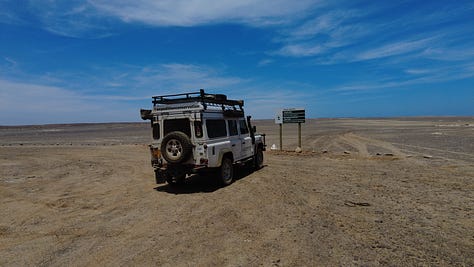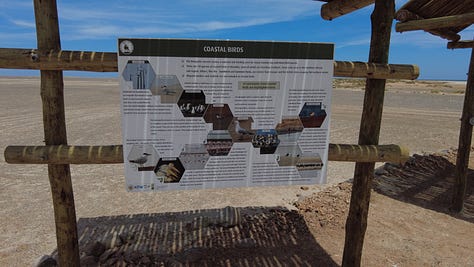Towards Angola – a New African Country for us and the Beginning of Our Journey Through the West Coast of Africa
Before we left Namibia, we said goodbyes to some of our favorite places and then crossed to Angola through the small border of Calueque. Angola turned out to be a bit challenging, but beautiful.
Happy Easter!! 🐣 It’s been almost two months since the last post, but we’ve been on the road all the time – and it’s been hectic, to say the least!
We haven't had enough strong networks to publish because we chose routes that often pass through remote areas. Also, time to sit down and write has been scarce, as we’ve been constantly on the move.
A lot has happened since the last post, and we’ve already driven through Angola, the Democratic Republic of the Congo (DRC), the Republic of Congo, Cameroon, and Nigeria. I’m writing this post for you in a lovely apartment in Cotonou, Benin, where we now have about a week to rest and apply for the Ghana visa.
So we’re running seriously behind on these stories, but now we’re trying our best to catch up! Let’s start from Angola, a beautiful country, albeit challenging, as we don’t speak Portuguese.
From Sunny Windhoek Towards Humid Angola
We had the Congos visas in our passports, no idea where to actually get the Nigerian visa at that point (only a hope that we could get it in Congo Brazzaville), and a lot of enthusiasm and a tingling sensation in our stomachs when we said goodbye to our Windhoek friends and started Honey Badger the Defender to head north—a lot north—all the way to Finland, eventually.
We left Windhoek (Namibia) around mid-February and headed first to the Atlantic coast to say our goodbyes to one of our favorite cities on the continent of Africa: Swakopmund.
This time, we spent only three nights in the town we have loved so much during our years of touring in Southern Africa. Swakopmund has always been like a haven where we have rested, walked on the beaches, and spent good times with friends. And I would lie if I said I didn’t feel wistful. Maybe we’ll return someday, but it will take some years.
From Swakopmund, we continued driving on the west coast of Namibia and through the arid but beautiful Skeleton Coast National Park. On the way, we spent nights wild camping in the Namibian wilderness, where it was literally just us and the vast landscapes—and the animals. We have always loved these characteristics in Namibia, and these are the ones we will miss.
A brown hyaena slept about fifty meters from our car while we were wild camping in the Ugab Menhir 4x4 track. :)



Saying Goodbyes to the Desert-Adapted Elephants, too
We still had one place we wanted to visit before leaving Namibia: the fantastic riverbed of the Hoanib River in the Kunene, home to the desert-adapted elephants.
We heard from locals that the riverbed was still dry in late February, even though it had already rained a bit, so we immediately decided to take this extra detour and stop by for a night to search for the ellies. We’ve been here twice before, but this place is so unique that you could visit it a thousand times and still be amazed and intrigued by its immense beauty!
Finding the elephants took quite a while, as they were far away. Still, luckily, we decided to drive to the end of the Hoanib riverbed track, further than we had originally planned, and there we finally found the elephants!
We spent almost an hour just admiring them and observing their day. Moments like these are one of the best things overlanding can provide—solitude in the wilderness with wild animals. ♥︎ We didn’t find the solitude desert-adapted lion mentioned in the video below, although we heard that he had been nearby just a few days before. But at least finding the elephants made it all worthwhile.
Here is a video that we made of our fantastic “farewell” visit to the Hoanib River (remember to put the sound on!):
After visiting the Hoanib River, we drove north to Ruacana and briefly stopped to see the Ruacana Falls, which we hadn’t seen in all these years and several months spent in Namibia. They turned out to be beautiful and worth the visit.
★ Upgrade your subscription now: get 15% OFF FOR LIFE and LOADS of EXTRA CONTENT & GOODIES!!! ★
Crossing to Angola From Calueque
Most overlanders cross from Namibia to Angola through the big border of Santa Clara, as the road on Angola’s side is a good tar road. However, the area on Namibia’s side, the Oshakati region, is not very safe, and this route is a longer drive when you are going towards the Angolan coast.
Since it had not yet rained much, we chose to use the tiny border of Calueque. We knew the road on the Angolan side would be a dirt track of various conditions, but it should still be dry and not too tricky to drive.
The border crossing took longer than anticipated because the Namibian officials sent us back to Outapi for a new police clearance certificate for Honey Badger the Defender. Our old one was from the end of 2023, as many police stations have refused to issue these certificates anymore. We tried to explain this and pleaded to the officials, but to no avail. We had no choice but to make an 84-kilometer detour to Outapi and get a new one. This detour took almost four hours (!) before we were back at the border, and it messed up our planned schedule.
The border crossing went smoothly after that, and we started driving the Calueque-Xangongo track (EN110), which began as a pretty decent dirt road. However, as it was already afternoon, we didn’t have time to drive far anymore, and we soon had to find a place to wild camp.
Finding a place to stay the night was not easy, as along this road, many villages were close to each other. So, eventually, we settled for a vast space between two villages, and it didn’t take long after we had parked for some curious people to come to say hi. Even though we didn’t have a mutual language, they were all friendly, and we managed to ask permission to sleep there.
A few kids lingered nearby until it was dark, and then they left home. After that, it was a peaceful night and morning. We ate breakfast and watched a few Southern Ground Hornbills (aka Thunderbirds) linger and shout nearby before continuing towards Xangongo.
The EN110 track was a much slower drive than we had initially thought. Lots of big potholes, ruts, and narrow tracks took an hour after an hour. However, we were happy that it was dry, as if it had been raining, it would’ve been a mud-wade…
Almost five hours later, the last 12 kilometers to the town of Xangongo was a vast and smooth dirt road, as they were building this road anew (badly needed, yes, but who knows how long this will take).
Welcome to Angola 🇦🇴 – We Only Speak Portuguese
Our first and only task in Xangongo was getting a SIM card and data packages. This was a much more challenging task than usual, as the people spoke only Portuguese, and we don’t, only a little bit of Spanish, which didn’t help.
Luckily, a Namibian guy who was visiting his mother in Xangongo spotted us at the phone shop and saved us by acting as a translator. We finally scored our SIM cards.
Another challenge in Angola was getting cash from an ATM. Few ATMs accepted foreign cards, and finding one took some sweet time! The excellent iOverlander app, which we regularly use, marks a few working ATMs, so check them and avoid looking for one for hours!
Fantastic Views and an Unpleasant Surprise
A few days into Angola, we had our first gorgeous camping spot at Serra da Leba. Just look at those views! It was an unofficial camp spot, so basically just wild camping, but we had to pay 3000 Angolan kwanza (a little less than 3€) for the night. We also had another overlanding couple (on their way south) camping further away. It was a peaceful night and a great morning with stunning breakfast views.
In the morning, we continued our way towards Luanda via Lobito, where we spent a humid night with a few other overland cars at the beach of a local restaurant. How humid it actually was at the beach took us a bit by surprise, as the climate was different from that in dry Namibia.
Luckily, a little breeze helped us sleep better at our Icarus roof tent. We had initially thought of spending 2-3 nights on this beach, but after getting there and seeing the place, which was not as nice as we thought, we only stayed one night and continued our way.
Soon after this, we had an unpleasant surprise one afternoon: we noticed that our clutch master cylinder, which had been changed only three months ago (!), was probably leaking! We were not happy…
Suddenly, there were the tell-tale signs of drops of fluid in the pedal compartment, which usually only means one thing in a Defender: a leaking master cylinder. After considering the situation, we decided to try to source a new master cylinder in Luanda and get it fixed, as there wasn’t anything else that we could do at that moment.
We didn’t buy a master cylinder as a spare in Windhoek, even though we initially had thought of doing so, and now we regret it. But as it was changed so recently, we kinda forgot about it.
And you can’t always think about everything, so giving yourself a hard time is not helping. You are human; sometimes you forget things and make mistakes. That’s how life is. Then you solve the problems and move on. :)
Fortunately, the clutch was still working well. There were only a few small drops, and the master reservoir was full of clutch fluid, so we made it safely to Luanda.
What happened then in Luanda?
We’ll continue it in the next post, as this one turned out to be a “monster” length already… 😉
So stay tuned for the next chapter of our overlanding adventure through the West Coast of Africa—from south to north!










